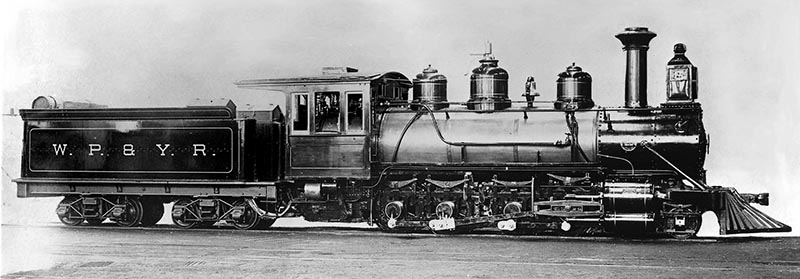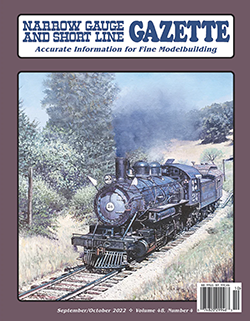The fabled White Pass & Yukon Route (WP&YR) was and is a narrow gauge railroad like no other in North America. Born out of the need to transport goods and materials north to support the Klondike Gold Rush, the railroad was overdue to the narrow gauge fad of the late nineteenth century. The isolation and the unique scenery have secured its continued existence well into the twenty-first century. In 1898 the railroad was young and the need for cheap locomotives was immediate. The White Pass acquired five used engines from the Columbia & Puget Sound Railroad in Washington between July and September. Several of these locomotives had a laundry list of previous owners with questionable maintenance histories. Their stories have been covered in detail in the first three articles of this series. None of these locomotives were particularly well suited for the steep grades, sharp curves, frigid cold, and generally wet conditions found in southeast Alaska. The White Pass placed an order in December 1898 with the Baldwin Locomotive Works of Philadelphia, Pa., for a pair of brand new engines built to handle the unique conditions of the line.
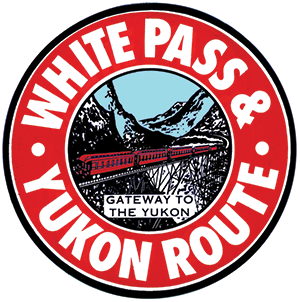 The Baldwin Locomotive Works was the premiere steam locomotive manufacturer at the turn of the twentieth century. Baldwin had numerous patents and one of those was for the Vauclain compound steam locomotive, named after Samuel M. Vauclain who had in 1889 patented a way of using both low- and high-pressure steam to power a locomotive more efficiently. In 1896, Mr. Vauclain became a member of the Board of directors at Baldwin. It was during this time that there seems to have been a push to sell Vauclain compound locomotives, with many large class 1 railroads buying them at the time. Baldwin built two Vauclain compound locomotives for the White Pass in January of 1899.
The Baldwin Locomotive Works was the premiere steam locomotive manufacturer at the turn of the twentieth century. Baldwin had numerous patents and one of those was for the Vauclain compound steam locomotive, named after Samuel M. Vauclain who had in 1889 patented a way of using both low- and high-pressure steam to power a locomotive more efficiently. In 1896, Mr. Vauclain became a member of the Board of directors at Baldwin. It was during this time that there seems to have been a push to sell Vauclain compound locomotives, with many large class 1 railroads buying them at the time. Baldwin built two Vauclain compound locomotives for the White Pass in January of 1899.
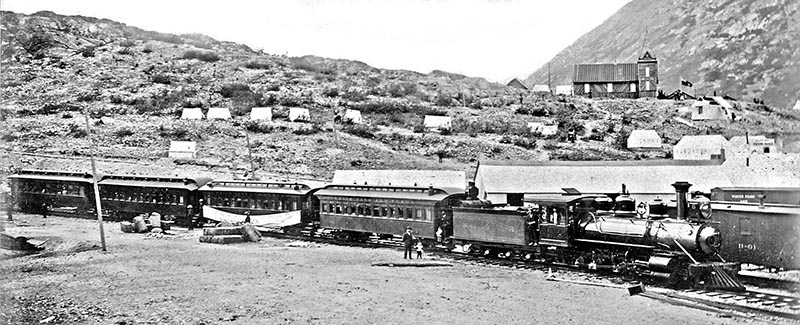
ABOVE: WP&YR locomotive No. 6 has pulled the first passenger coaches into Bennett, B.C., in July of 1899. Bennett was where many of the Klondikers built boats to proceed north to various gold strikes in the Yukon Territory. St. Andrew’s Presbyterian Church can be seen in the background and aside from railroad structures; it is the only building left in Bennett from the gold rush days. —Photo by H.C. Barley, Bruce Pryor collection
The premise of the Vauclain compound was to use both a high-pressure piston and a low-pressure piston connected in parallel to a common cross-head driving the main rod of a steam locomotive. The low-pressure piston was roughly 66 percent larger than the high-pressure piston to equalize the forces being applied. Steam first entered the high-pressure cylinder and expanded, applying force, and moving the piston. This steam is then exhausted through a complex valve assembly into the low-pressure cylinder and used again. When starting a Vauclain compound, a manually operated starting valve applied high pressure steam into the low-pressure cylinder also. The system did not produce more power; rather it increased efficiency both in fuel and water usage. However, the added efficiency was offset by increased maintenance costs. The combination of the low- and high-pressure pistons invariably caused uneven wear on the crosshead, and the complex valve coupled with the starting valve added to the maintenance costs.
The two Vauclain compound locomotives built for the WP&YR were 2-8-0 consolidation types, numbered 6 and 7. They were construction numbers 16455 and 16456, respectively. The twins had 11½- x 20-inch high-pressure cylinders mounted below the 19- x 20-inch low-pressure cylinders. They had 38-inch diameter drivers and produced about 21,000 pounds of tractive effort which was quite an increase over any of the used engines the WP&YR had acquired. Both locomotives were put to work as soon as they arrived in Skagway in March 1899 bucking snow and hauling materials for the railroad’s construction. Number 6 pulled the first passenger cars to Bennett, B.C., in July of 1899—a train consisting of 4 coaches. Number 7 pulled a Y.M.C.A. excursion train to Bennett on August 5th, 1899, consisting of two coaches and five flat-cars fitted with seats. The two Vauclain compound locomotives were renum-bered 56 and 57 in 1900 and continued to labor together on the White Pass until 1906 when #57 was sold…
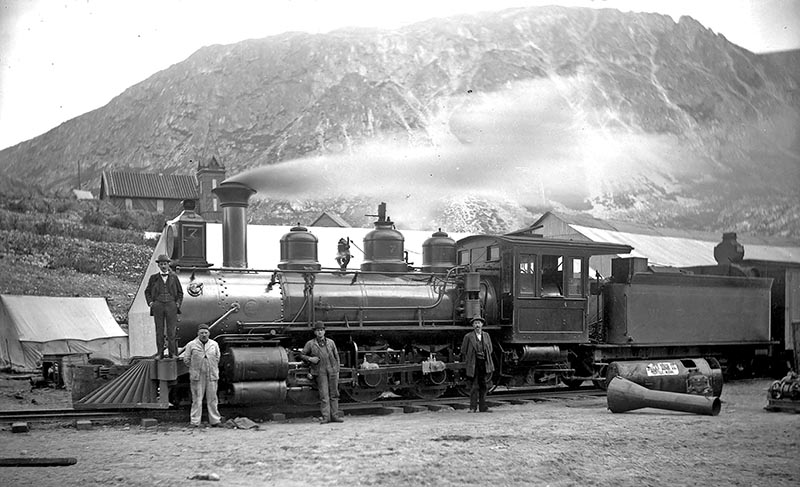
ABOVE: WP&YR locomotive No. 7 poses with the crew at Bennett, B.C., before returning to Skagway. The locomotive looks nice and shiny, but dents in the cylinder covers show that she has already had some minor incidents. —Photo H.C. Barley, Dedman’s Photo Shop, Rob Bell collection


